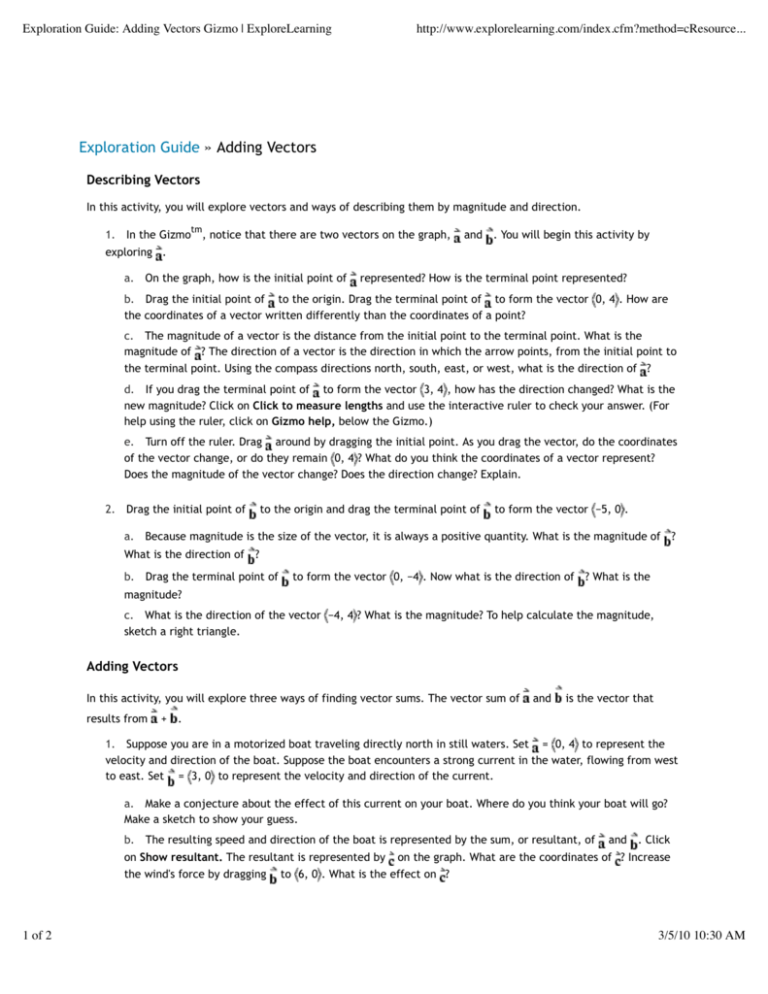
Exploration Guide: Adding Vectors Gizmo | ExploreLearning
http://www.explorelearning.com/index.cfm?method=cResource...
Exploration Guide » Adding Vectors
Describing Vectors
In this activity, you will explore vectors and ways of describing them by magnitude and direction.
tm
1. In the Gizmo , notice that there are two vectors on the graph,
and . You will begin this activity by
exploring .
a. On the graph, how is the initial point of
represented? How is the terminal point represented?
b. Drag the initial point of to the origin. Drag the terminal point of to form the vector 0, 4 . How are
the coordinates of a vector written differently than the coordinates of a point?
c. The magnitude of a vector is the distance from the initial point to the terminal point. What is the
magnitude of ? The direction of a vector is the direction in which the arrow points, from the initial point to
the terminal point. Using the compass directions north, south, east, or west, what is the direction of ?
d. If you drag the terminal point of to form the vector 3, 4 , how has the direction changed? What is the
new magnitude? Click on Click to measure lengths and use the interactive ruler to check your answer. (For
help using the ruler, click on Gizmo help, below the Gizmo.)
e. Turn off the ruler. Drag around by dragging the initial point. As you drag the vector, do the coordinates
of the vector change, or do they remain 0, 4 ? What do you think the coordinates of a vector represent?
Does the magnitude of the vector change? Does the direction change? Explain.
2. Drag the initial point of
to the origin and drag the terminal point of
to form the vector −5, 0 .
a. Because magnitude is the size of the vector, it is always a positive quantity. What is the magnitude of ?
What is the direction of ?
b. Drag the terminal point of
to form the vector 0, −4 . Now what is the direction of ? What is the
magnitude?
c. What is the direction of the vector −4, 4 ? What is the magnitude? To help calculate the magnitude,
sketch a right triangle.
Adding Vectors
In this activity, you will explore three ways of finding vector sums. The vector sum of
results from
and
is the vector that
+ .
1. Suppose you are in a motorized boat traveling directly north in still waters. Set = 0, 4 to represent the
velocity and direction of the boat. Suppose the boat encounters a strong current in the water, flowing from west
to east. Set = 3, 0 to represent the velocity and direction of the current.
a. Make a conjecture about the effect of this current on your boat. Where do you think your boat will go?
Make a sketch to show your guess.
b. The resulting speed and direction of the boat is represented by the sum, or resultant, of
and . Click
on Show resultant. The resultant is represented by on the graph. What are the coordinates of ? Increase
the wind's force by dragging to 6, 0 . What is the effect on ?
1 of 2
3/5/10 10:30 AM
Exploration Guide: Adding Vectors Gizmo | ExploreLearning
http://www.explorelearning.com/index.cfm?method=cResource...
c. Make a conjecture about how the coordinates of
are obtained from the coordinates of
and . Click
on Show sum computation to check your hypothesis.
d. Vary the coordinates of
and
to convince yourself that adding vectors simply means adding the
coordinates of the vectors. Notice that changing the location of
2. Turn off Show resultant. Place the initial point of
of on the terminal point of and set = −4, 1 .
a. Calculate
+
by adding the coordinates of
or
does not change what the resultant is.
at the origin and set
= −2, 3 . Place the initial point
and . How does that answer compare to the coordinates
of the terminal point of ? Click on Show resultant and Show sum computation to check your answers.
b. Turn on Show parallelogram. How do
and
relate to the parallelogram? How does the resultant vector
relate to the parallelogram?
c. Drag
and
to make new vectors. Be sure to keep the initial point of
on the origin and the initial
point of
on the terminal point of . Is the vector sum always the same as the coordinates of the terminal
point of ? Is the resultant vector always the diagonal of the parallelogram in which
and
are two of the
sides? Make some sketches representing these findings.
3. Use the Gizmo and what you have learned about vector addition to find the following vector sums.
a. Find 1, 3 + −3, −4 .
b. What is the resultant of
= 0, 4 and
c. Find the sum of
= −3, 0 and
d. What is
+
if
=
and
= −5, 0 ?
= −4, 0 .
= 3, 4 and
= −3, −4 ? This is called a state of equilibrium.
© 2010 ExploreLearning. All rights reserved. Gizmo and Gizmos are trademarks of ExploreLearning. Please carefully review the Terms &
Conditions of Use (7) and our Privacy Policy (8) before using this site. Your use of the site indicates your agreement to be bound by the
Terms & Conditions of Use.
2 of 2
3/5/10 10:30 AM






